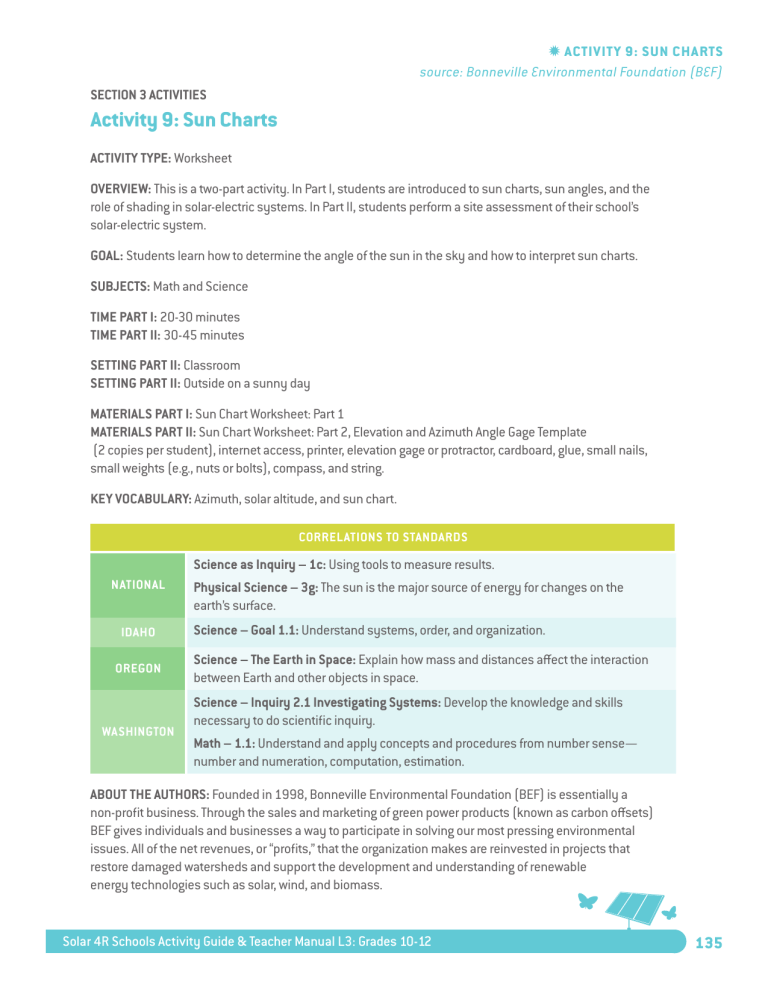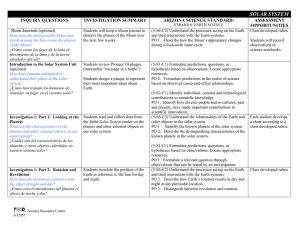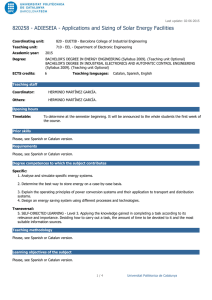
Activity 9: SUN CHARTS source: Bonneville Environmental Foundation (BEF) Section 3 Activities Activity 9: Sun Charts ACTIVITY TYPE: Worksheet Overview: This is a two-part activity. In Part I, students are introduced to sun charts, sun angles, and the role of shading in solar-electric systems. In Part II, students perform a site assessment of their school’s solar-electric system. Goal: Students learn how to determine the angle of the sun in the sky and how to interpret sun charts. Subjects: Math and Science Time PART I: 20-30 minutes Time PART II: 30-45 minutes Setting Part II: Classroom Setting Part II: Outside on a sunny day Materials Part I: Sun Chart Worksheet: Part 1 Materials Part II: Sun Chart Worksheet: Part 2, Elevation and Azimuth Angle Gage Template (2 copies per student), internet access, printer, elevation gage or protractor, cardboard, glue, small nails, small weights (e.g., nuts or bolts), compass, and string. Key Vocabulary: Azimuth, solar altitude, and sun chart. Correlations to Standards Science as Inquiry – 1c: Using tools to measure results. National Idaho Oregon Washington Physical Science – 3g: The sun is the major source of energy for changes on the earth’s surface. Science – Goal 1.1: Understand systems, order, and organization. Science – The Earth in Space: Explain how mass and distances affect the interaction between Earth and other objects in space. Science – Inquiry 2.1 Investigating Systems: Develop the knowledge and skills necessary to do scientific inquiry. Math – 1.1: Understand and apply concepts and procedures from number sense— number and numeration, computation, estimation. About the Authors: Founded in 1998, Bonneville Environmental Foundation (BEF) is essentially a non-profit business. Through the sales and marketing of green power products (known as carbon offsets) BEF gives individuals and businesses a way to participate in solving our most pressing environmental issues. All of the net revenues, or “profits,” that the organization makes are reinvested in projects that restore damaged watersheds and support the development and understanding of renewable energy technologies such as solar, wind, and biomass. Solar 4R Schools Activity Guide & Teacher Manual L3: Grades 10-12 135 Activity 9: SUN CHARTS source: Bonneville Environmental Foundation (BEF) Sun Charts Worksheet: Part 1 Before installing a solar-electric system, a site survey is conducted to determine the best location for the system. Generally, a PV system is oriented south and in a position where it will not be obstructed by shadows. A sun chart can be used to help determine possible obstructions that will affect a PV system’s performance over the course of a year. A sun chart is a graph of solar azimuth and solar altitude. Azimuth is the sun’s location east and west of true south in the sky. Solar altitude is a measure of the sun’s location in degrees above the the horizon. The chart can help to determine if there are critical times of the day and year when the PV system will receive too much shading to make the installation worth while. The sun chart below shows the movement of the sun across the sky over the course of the day for an entire year. Charts vary depending on what latitude and longitude is used. The chart below represents the sun’s path across the sky at latitude 45 and longitude -120. Using the sun chart provided, complete the exercise by answering the questions below. 136 Solar 4R Schools Activity Guide & Teacher Manual L3: Grades 10-12 Activity 9: SUN CHARTS source: Bonneville Environmental Foundation (BEF) 1. The first day of summer (June 21st), the azimuth at sunrise is 55°. What is the azimuth at 9 a.m. on the same day? A. 100° B. 95° C. 110° D. 105° 2. What is the approximate maximum altitude the sun reaches on March 20th? A. 40° B. 45° C. 50° D. 55° 3. Assume that the PV will be shaded if the altitude is less than 30° when the azimuth is 120°. The months of the year when the array will be shaded between 9 a.m. and 3 p.m. include: A. April, May, June B. January, February, March C. November, December, January D. December 4. The maximum, annual solar elevation between 9 a.m. and 3 p.m. sun time is closest to: A. 30 B. 50 C. 60 D. 70 5. The minimum, annual solar elevation between 9 am and 3 pm sun time is closest to: A. 10 B. 20 C. 30 D. 40 Solar 4R Schools Activity Guide & Teacher Manual L3: Grades 10-12 137 Activity 9: SUN CHARTS source: Bonneville Environmental Foundation (BEF) Sun Charts Worksheet: Part 2 Answer Key 1. The first day of summer (June 21st), the azimuth at sunrise is 55°. What is the azimuth at 9 a.m. on the same day? A. 100° B. 95° C. 110° D. 105° 2. What is the approximate maximum altitude the sun reaches on March 20th? A. 40° B. 45° C. 50° D. 55° 3. Assume that the PV will be shaded if the altitude is less than 30° when the azimuth is 120°. The months of the year when the array will be shaded between 9 a.m. and 3 p.m. include: A. April, May, June B. January, February, March C. November, December, January D. December 4. The maximum, annual solar elevation between 9 a.m. and 3 p.m. sun time is closest to: A. 30 B. 50 C. 60 D. 70 5. The minimum, annual solar elevation between 9 am and 3 pm sun time is closest to: A. 10 B. 20 C. 30 D. 40 138 Solar 4R Schools Activity Guide & Teacher Manual L3: Grades 10-12 Activity 9: SUN CHARTS source: Bonneville Environmental Foundation (BEF) Sun Charts Worksheet: Part 1 Before installing a solar-electric system, a site survey is conducted to determine the best location for the system. Generally, a PV system is oriented south and in a position where it will not be obstructed by shadows. A sun chart can be used to help determine possible obstructions that will affect a PV system’s performance over the course of a year. A sun chart is a graph of solar azimuth and solar altitude. Azimuth is the sun’s location east and west of true south in the sky. Solar altitude is a measure of the sun’s location in degrees above the the horizon. The chart can help to determine if there are critical times of the day and year when the PV system will receive too much shading to make the installation worth while. The sun chart below shows the movement of the sun across the sky over the course of the day for an entire year. Charts vary depending on what latitude and longitude is used. The chart below represents the sun’s path across the sky at latitude 45 and longitude -120. Using the sun chart provided, complete the exercise by answering the questions below. 136 Solar 4R Schools Activity Guide & Teacher Manual L3: Grades 10-12 Activity 9: SUN CHARTS source: Bonneville Environmental Foundation (BEF) 1. The first day of summer (June 21st), the azimuth at sunrise is 55°. What is the azimuth at 9 a.m. on the same day? A. 100° B. 95° C. 110° D. 105° 2. What is the approximate maximum altitude the sun reaches on March 20th? A. 40° B. 45° C. 50° D. 55° 3. Assume that the PV will be shaded if the altitude is less than 30° when the azimuth is 120°. The months of the year when the array will be shaded between 9 a.m. and 3 p.m. include: A. April, May, June B. January, February, March C. November, December, January D. December 4. The maximum, annual solar elevation between 9 a.m. and 3 p.m. sun time is closest to: A. 30 B. 50 C. 60 D. 70 5. The minimum, annual solar elevation between 9 am and 3 pm sun time is closest to: A. 10 B. 20 C. 30 D. 40 Solar 4R Schools Activity Guide & Teacher Manual L3: Grades 10-12 137 Activity 9: SUN CHARTS source: Bonneville Environmental Foundation (BEF) Sun Charts Worksheet: Part 2 Answer Key 1. The first day of summer (June 21st), the azimuth at sunrise is 55°. What is the azimuth at 9 a.m. on the same day? A. 100° B. 95° C. 110° D. 105° 2. What is the approximate maximum altitude the sun reaches on March 20th? A. 40° B. 45° C. 50° D. 55° 3. Assume that the PV will be shaded if the altitude is less than 30° when the azimuth is 120°. The months of the year when the array will be shaded between 9 a.m. and 3 p.m. include: A. April, May, June B. January, February, March C. November, December, January D. December 4. The maximum, annual solar elevation between 9 a.m. and 3 p.m. sun time is closest to: A. 30 B. 50 C. 60 D. 70 5. The minimum, annual solar elevation between 9 am and 3 pm sun time is closest to: A. 10 B. 20 C. 30 D. 40 138 Solar 4R Schools Activity Guide & Teacher Manual L3: Grades 10-12 Activity 9: SUN CHARTS source: Bonneville Environmental Foundation (BEF) Sun Charts Worksheet: Part 2 Conducting an Obstacle Survey A sun chart is useful in determining where to locate a solar-electric system because the system needs direct light to shine on it to operate effectively. In most places in the United States, the sun shines on a solar-electric system for 4-8 hours a day. During those important hours of sunlight, we need to make sure there are no obstacles obstructing the path of light to the solar panels because shadows on a solar panel cause the panels to produce less power. Conducting an obstacle survey or “site survey” helps determine a suitable location for a solar-electric system. During the survey, you will check for blockage of the sun by buildings, telephone poles, or trees that could obstruct sunlight from reaching the solar-electric system. To conduct an obstacle survey for a solar-electric system installation, you’ll need to gather information regarding the location of the sun during the peak hours of sunlight (8:00 a.m. to 4:00 p.m.). 1. Download a Sun Chart: Download a sun chart for your location at the Solar Radiation Monitoring Lab Sun Chart Program website (http:// solardat.uoregon.edu/SunChartProgram.html). Click “Look up location with US 5-digit zip code” and enter the zip code of your school. Use the default settings for the remaining fields on the page and click “Create Chart” at the bottom. Print your sun chart and spend some time familiarizing yourself with the sun’s path at your school. Now choose a place that you think would be a good location for a solar-electric system, or conduct an obstacle survey for the existing location of your school’s Solar 4R Schools array. 2. Make an Elevation Gauge: Paste a copy of the Elevation and Azimuth Gauge Template onto a piece of cardboard. The zero on the scale represents true south. Draw a line from the reference circle through the zero mark to the edge of the piece of cardboard. Make a gauge needle using a thin, straight piece of wood (like balsa) attached to the cardboard with a small, picture- frame nail pushed through the reference circle. A piece of string can also be used in place of a wooden needle. To measure elevation, use a compass to determine true south, and point the zero on the scale to true south. Select an object on the horizon and aim the needle at the top of the object. For example, let’s say there is a tree on the horizon to the left (east) of true south. With the elevation gauge aimed at true south, pointing the needle at the top of the tree might tell you that the top of the tree reaches an elevation 20° east of south. Solar 4R Schools Activity Guide & Teacher Manual L3: Grades 10-12 139 Activity 9: SUN CHARTS source: Bonneville Environmental Foundation (BEF) 3. Make an Azimuth Angle Gauge: Paste a copy of the Elevation and Azimuth Gauge Template onto a piece of cardboard. Trim the cardboard along the site line (you will site along this edge for elevation measurements). Put a small nail through the center of the reference circle. Tie one end of a light string to the nail and the other end to any small weight (e.g., a nut or bolt) To measure azimuth, aim the site line towards the south pointing the 0° line at true south. Slide the attached string along the scale to determine the location of objects on the horizon. For example, with the azimuth gauge aimed at true south, aiming the string at the tree might tell you that the location of the tree at 20° east of south. 4. Measure Objects on the Horizon: Start from the east and work your way around through south to the west. Mark the tops or key points of prominent objects on the horizon. Record the elevation and azimuth numbers for each of these locations. You might label each set of numbers by a defining feature of the object (e.g., coniferous tree, tall hedge row, building with antenna, etc). 5. Insert Obstacle Points on the Sun Chart: Read the azimuth angle off the azimuth gage where the pointer passes the azimuth angle number scale. Measure the elevation angle for the same object by sighting along the sight line on the elevation gage. Read the elevation angle where the string crosses the elevation angle scale. Make sure that the string is not binding on the gage when you make the reading. Mark the azimuth and elevation angles of each high point on the sun chart. Mark the position of the horizon on your sun chart by drawing lines between the elevation points you marked on the chart. Sun chart with elevation and azimuth marked 6. Understanding Your Results The information provided by an obstacle survey is essentially all you need to determine how much power can be generated by a solar-electric system at a given location. The solar-electric system should have at least four hours of unobstructed sunlight each day. If the location you chose is shaded during peak sun hours, then you might consider moving the solar-electric system to a better location, trimming obstacles like trees, or aiming the collector so that it gets more unobstructed sun. For example, if the sun is good in the morning, but blocked in part of the afternoon, you could think about aiming the collector a bit east of south in order to get more morning sun. 140 Solar 4R Schools Activity Guide & Teacher Manual L3: Grades 10-12 Elevation and Azimuth Angle Gauge Template Activity 9: SUN CHARTS source: Bonneville Environmental Foundation (BEF) Solar 4R Schools Activity Guide & Teacher Manual L3: Grades 10-12 141 142 Solar 4R Schools Activity Guide & Teacher Manual L3: Grades 10-12









